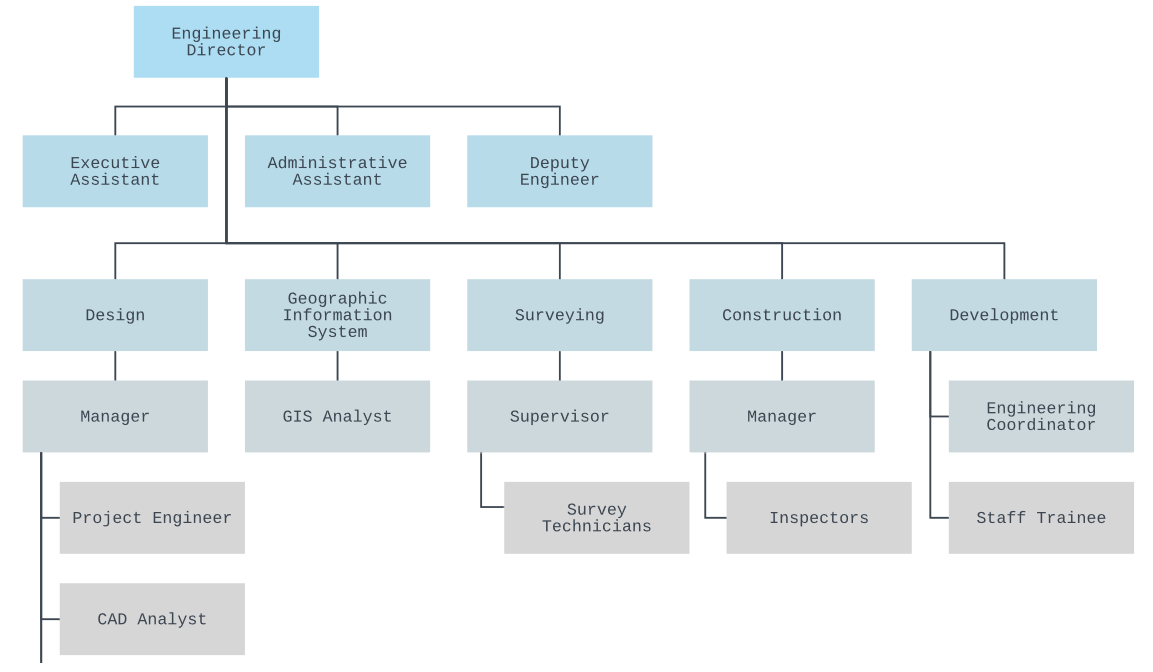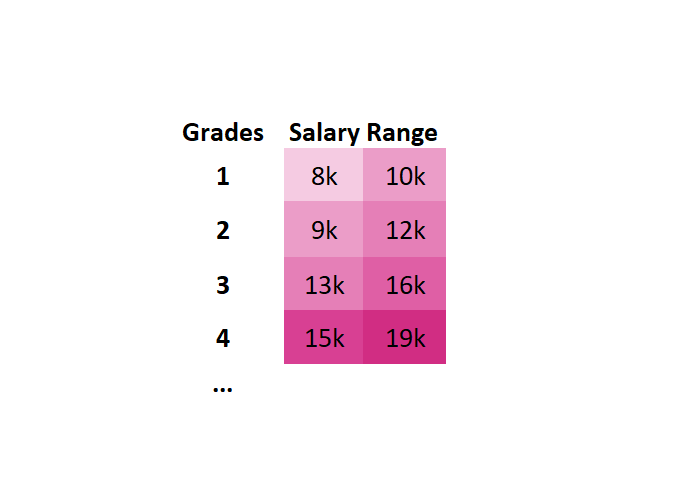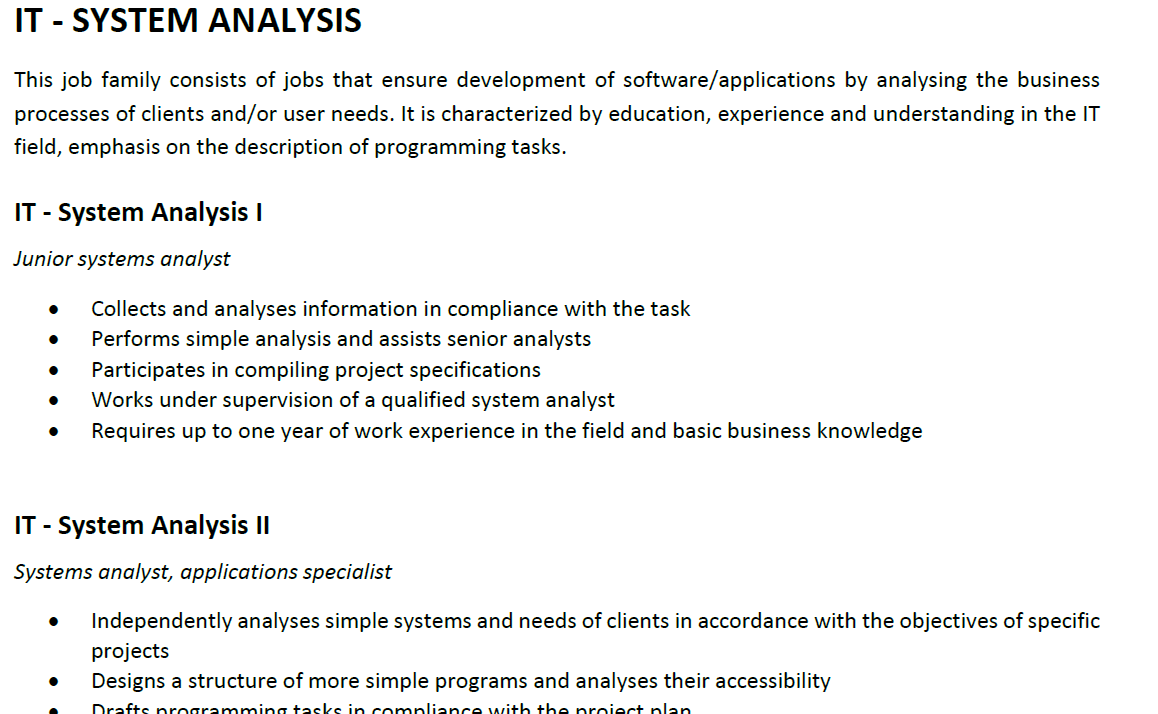5 Tips for Creating Efficient Organizational Structures, Pay Grades and Job Level Systems
2020
Jul 15
Jul 15

Most businesses at some point in their lifespan implement methods for the management of their organizational structures, position levels, and salaries. These concepts are often confused because of the partial overlap they have. Following are definitions, examples, and a few tips on avoiding confusion and ineffective use of related systems.
Organizational structure is mainly a hierarchy that defines the chain of command, promotes communication, and shows the possible ways of career growth for the staff. It is usually represented by a graphical chart. There are four main types of such hierarchies – functional, divisional, matrix and flat. Here is an example of such structure:

Pay grade system is also a hierarchical structure, where a grade represents a specific salary range and is used in an effort to refer to it more easily. It is usually a ruler like scale, say from 1 to 20. So, instead of mentioning the salary band of a position, like 13-16k, organization can use a grade 3, etc. These grades sometimes also have an assigned description of required seniority or experience to reach it, however, as we will discuss later, that might have important limitations. Here is an example of a simple pay grade system:

Job level or position evaluation system is partially hierarchical as well but in a limited way. It helps management and employees to understand positions, their requirements, responsibilities, used tools, differences between seniority levels etc. There are mainly two ways to evaluate positions: by matching to a catalogue filled with job descriptions, like the ones posted in advertisements, or by using a more in-depth process of analyzing criteria. Here is an example of the former:

Even though these are three similar concepts, their purposes are quite different, as are the methods to implement them. Working with many businesses and the systems they have, allows us to identify which methods work efficiently and which become impractical. Our experience shows that even a specialist, without the expertise in HR field is able to create efficient systems, if a few main principles are followed.
Keep it simple, it is going to be used across the board
While huge organizational structures can also become difficult to put on one chart, this is especially important for job evaluation and pay grade systems. Do not forget that they will be used not only by the HRs or the top executives, but managers, team leads and everyone else. Complicated systems also mean that training is probably going to be required for the newly hired managers. It is therefore essential to ensure that the chosen solution is as intuitive and easy to understand as possible. Overly complicated or ungrounded methods will raise questions like “why is my salary grade 8 and not 9”, “why is a senior accountant assigned a grade 12, but a senior tester 14, when they are both senior positions?”, “why does our job evaluation scale start at 4 and not 1?”.
Example (job levels): Indeed, why not start from one? Let us say that level 1 is for junior, 2 for mid, 3 for senior, 4 for lead etc. This is very intuitive and easy to understand.
Example (pay grades): Similarly as with job levels, we can start at pay grade 1 for the lowest salary range and go up, or, perhaps it is easier when the grade reflects the median of a salary range, so grade 13 would represent the 12-14k salary range etc.
Want the junior level to start at 10 or the pay grade at 200? That is fine but be ready to explain the reasons behind it to your middle management, team leads, and other curious employees. There are many solutions out there already, so if you are choosing one of them, study it and make sure you understand it enough to be able to explain it to your colleagues.
Job evaluation system should reflect the specifics of different jobs. That is the main point of having it. Going back to the 4 seniority levels mentioned in the previous example – this should not be a standard for all positions. Some job functions have different number of seniority levels, that start from an assistant and go up to the level of director, like in sales. The opposite is true for the positions that have a rather narrow scale of seniority, like say, a Product layout specialist. So, identify these levels for each of your positions and implement a leveling method that does not ignore them. You can always choose a ready-made market job catalogue, that will have the most common jobs already classified into levels. Also you might want consider introducing half levels to better suit the positions that are in the transitioning stage between any two levels, but do not go overboard – with each such addition the complexity goes up as well as the administration time.
Decentralization – distinctions are important
There are quite a few cases where these systems (organizational structure, pay grade system and job leveling system) are merged. Some do this for the sake of simplicity, others – unintentionally. Thread carefully, as doing so and forgetting their essential differences can result in something that instead of simplifying the processes will do all of them equally poorly. Decentralization of concepts and processes sometimes keeps the essential clarity and order. This is closely related to tip no. 1 about keeping it simple and the following tips about flexibility, global methods, and favorite solutions.
Example: Referring to the initial illustrative examples above, instead of having clearly defined System Analysis job levels 1, 2 etc. and relevant pay grades alongside them, organizations sometimes choose to have just the pay grades, that try to reflect both – job levels and the salary ranges, at the same time. While this may seem like a good idea first, it is difficult to implement and might become confusing. What if a position is not complex, but the specialists are rare in the market and thus expensive to recruit? On one hand the grade should be higher because of the higher salary, on the other, it should still reflect that the position is not really that complex. This is especially bad for businesses that have a variety of job functions. So, what is the solution? Keep the theory-based job evaluation and market-based pay grade systems separate.
It should be flexible and easily amendable
Any system is only as good as it is efficient when working under pressure, dealing with exceptional cases or changes. And things are destined to change over time – positions and their responsibilities change, new managers replace the old ones and often want to make amendments. Over the hundreds of organizations that we look at each year, the worst functioning systems are the ones that are both – complicated and unable to adapt.
Some organizations waste a huge amount of resources and time crafting super specific and massive systems that suit the current situation perfectly, but collapse under their own weight as soon as quick changes need to be introduced. This is particularly the case for salary ranges – if a very strict and narrow range is assigned to a position, sooner or later you might have to choose between to hiring a key talent with a higher salary, or following your own set of strict rules.
Global methods
Working with international methods is great when they are suitable for the country or the market you operate in, however that is often not the case. Because most of them are made to appeal to all markets at once, some of these methods are too general and lack detail, others might not reflect the current market situation in your area. Also, with regards to flexibility, if your organization is using some of these methods by the book, then you are likely unable to update or bend them to better suit your current situation. A great thing about having your own system is that you can easily alter it and keep it up to date, without having to wait for someone to do it for you.
Whether you choose to implement your own systems, or use one of the existing ones, always keep yourself open to alternatives. After working with a single solution for a while you might think that it is the best out there, but new solutions and tools are created each year, so stay up to date.
The article is written by Fontes.
